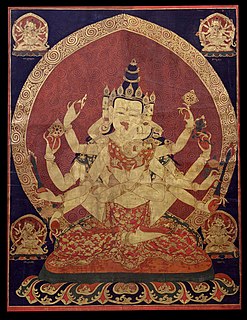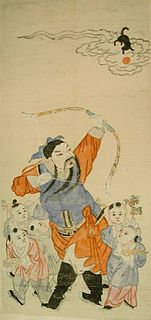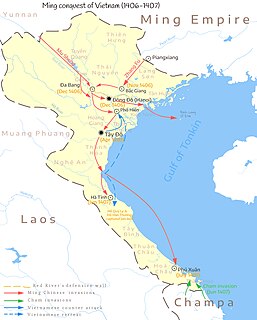
The Ming dynasty, officially the Great Ming, was the ruling dynasty of China from 1368 to 1644 following the collapse of the Mongol-led Yuan dynasty. The Ming dynasty was the last imperial dynasty of China ruled by Han Chinese. Although the primary capital of Beijing fell in 1644 to a rebellion led by Li Zicheng, numerous rump regimes ruled by remnants of the Ming imperial family—collectively called the Southern Ming—survived until 1662.

The Hongwu EmperorZhu Yuanzhang, was the founding emperor of the Ming dynasty, reigning from 1368 to 1398.

The Hồ dynasty was a short-lived Vietnamese dynasty consisting of the reigns of two monarchs, Hồ Quý Ly (胡季犛) in 1400–01 and his second son, Hồ Hán Thương (胡漢蒼), who reigned the kingdom of Đại Việt from 1401 to 1406. The practice of bequeathing the throne to a designated son was similar to what had happened in the previous Trần dynasty and was meant to avoid sibling rivalry. Hồ Quý Ly's eldest son, Hồ Nguyên Trừng, played his part as the dynasty's military general. In 2011, UNESCO declared the Citadel of the Hồ Dynasty in Thanh Hóa Province a world heritage site.

The Huolongjing, also known as Huoqitu, is a Chinese military treatise compiled and edited by Jiao Yu and Liu Bowen of the early Ming dynasty (1368–1683) during the 14th-century. The Huolongjing is primarily based on the text known as Huolong Shenqi Tufa, which no longer exists.
Fuji is a method of "planchette writing", or "spirit writing", that uses a suspended sieve or tray to guide a stick which writes Chinese characters in sand or incense ashes.

The exact nature of relations between Tibet and the Ming dynasty of China (1368–1644) is unclear. Analysis of the relationship is further complicated by modern political conflicts and the application of Westphalian sovereignty to a time when the concept did not exist. The Historical Status of China's Tibet, a book published by the People's Republic of China, asserts that the Ming dynasty had unquestioned sovereignty over Tibet by pointing to the Ming court's issuing of various titles to Tibetan leaders, Tibetans' full acceptance of the titles, and a renewal process for successors of these titles that involved traveling to the Ming capital. Scholars in China also argue that Tibet has been an integral part of China since the 13th century and so it was a part of the Ming Empire. However, most scholars outside China, such as Turrell V. Wylie, Melvin C. Goldstein, and Helmut Hoffman, say that the relationship was one of suzerainty, Ming titles were only nominal, Tibet remained an independent region outside Ming control, and it simply paid tribute until the Jiajing Emperor (1521–1566), who ceased relations with Tibet.

The military of the Ming dynasty was the military apparatus of China from 1368 to 1644. It was founded in 1368 during the Red Turban Rebellion by the Ming founder Zhu Yuanzhang. The military was initially organised along largely hereditary lines and soldiers were meant to serve in self-sufficient agricultural communities. They were grouped into guards (wei) and battalions (suo), otherwise known as the wei-suo system. This hereditary guard battalion system went into decline around 1450 and was discarded in favor of mercenaries a century later.
The Battle of Kherlen was a battle between the Northern Yuan dynasty of Mongolia and Ming China that took place at the banks of Kherlen River (Kerulen) in the Mongolian Plateau on 23 September 1409.

For millennia, Chinese archery has played a pivotal role in Chinese society. In particular, archery featured prominently in ancient Chinese culture and philosophy: archery was one of the Six Noble Arts of the Zhou dynasty ; archery skill was a virtue for Chinese emperors; Confucius himself was an archery teacher; and Lie Zi was an avid archer. Because the cultures associated with Chinese society spanned a wide geography and time range, the techniques and equipment associated with Chinese archery are diverse. The improvement of firearms and other circumstances of 20th century China led to the demise of archery as a military and ritual practice, and for much of the 20th century only one traditional bow and arrow workshop remained. However, at the beginning of the 21st century, there has been a revival in interest among craftsmen looking to construct bows and arrows, as well as a practice technique in the traditional Chinese style.

The Ming–Hồ War or the Ming conquest of Đại Ngu was a military invasion of Đại Việt by the Ming dynasty of China. The campaign began with Ming intervention in support of a rival faction to the Hồ dynasty which ruled Đại Ngu, but ended with the incorporation of Đại Việt into the Ming dynasty as the province of Jiaozhi. The invasion is acknowledged by recent historians as one of the most important wars of the late medieval period, whereas both sides, especially the Ming, used the most advanced weapons in the world at the time.

Yongle Emperor's campaigns against the Mongols (1410–1424) was a military campaign of the Ming dynasty under the Yongle Emperor against the Northern Yuan. During his reign he launched several aggressive campaigns, defeating the Northern Yuan, Eastern Mongols, Oirats, and various other Mongol tribes.
A xunfu was an important imperial Chinese provincial office under both the Ming and Qing dynasties. However, the purview of the office under the two dynasties differed markedly. Under the Ming, the post originated around 1430 as a kind of inspector-general and ad hoc provincial-level administrator; such a xunfu is usually translated as a grand coordinator. However, after the Manchu conquest of China in the mid-17th century, xunfu became the title of a regular provincial governor overseeing civil administration.
The Ming campaign against the Uriankhai was an offensive military expedition campaign of the Ming dynasty's army led by General Feng Sheng against the Uriankhai horde of the Mongol chieftain Naghachu in Manchuria. In occurred in the territories around modern-day Beijing in 1387. Later that year, the Ming won with Uriankhai surrendering. The victory consolidated the Ming's rule over Northeast China and Northeast Asia.
The Peking Field Force was a modern-armed military unit that defended the Chinese imperial capital Beijing in the last decades of the Qing dynasty (1644–1912).
Xia Yuanji was a Ming dynasty government minister. He was born in Xiangyin County, Hunan Province, which was then part of Huguang Province. His ancestral home was Dexing, Jiangxi. Xia read the Classic of Poetry and became a Xiucai at the age of 23, joining the Guozijian. Early in his career, he saw service under the Hongwu Emperor and Jianwen Emperor. After the Yongle Emperor came to the throne, he was sent to inspect Suzhou Creek. Xia opposed both Zheng He's overseas voyages and the Yongle Emperor's campaigns against the Mongols.

Yongquan Temple is a Buddhist temple located on Mount Gu, in Jin'an District of Fuzhou, Fujian. It was first built in 783 during the Tang dynasty (618–907), and went through many changes and repairs through the following dynasties. Most of the present structures in the temple were repaired or built in the Jiajing period (1522–1566) in the Ming dynasty (1368–1644).
Sanzu Temple is a Buddhist temple located on Mount Tianzhu, in Qianshan, Anhui, China. Originally builtin 505 in the Northern and Southern dynasties (420–589), the temple has a history of over 1550 years, but it was destroyed and rebuilt many times because of war and natural disasters. The present version was completed in 1944.
Trần Thiêm Bình was a pretender to the Vietnamese throne during Hồ dynasty. He was mentioned as Chen Tian-ping (陳天平) in Chinese records.
The Battle of Palembang was a naval battle fought in 1407 between Ming China's treasure fleet commanded by Admiral Zheng He and the pirate fleet of Chen Zuyi at Palembang, Sumatra, in what is now modern Indonesia. The battle resulted in the defeat of Chen Zuyi, who was captured and sent to China for execution.
Sunü is an ancient Chinese goddess associated with music and sexuality. She is viewed as the divine sister of the Chinese war and sex goddess within mythologyJiutian Xuannü. She is traditionally portrayed as an highly skilled singer who plays a zither and Sunü's songs were known for their ability to pacify wild animals, inspire plants to grow, as well as change the seasons. "When she plays... it can make the wind warm in winter, snow in summer..." In the History of Chinese Literature (中国文学史), Sunü is imagined as the first female harp player.










